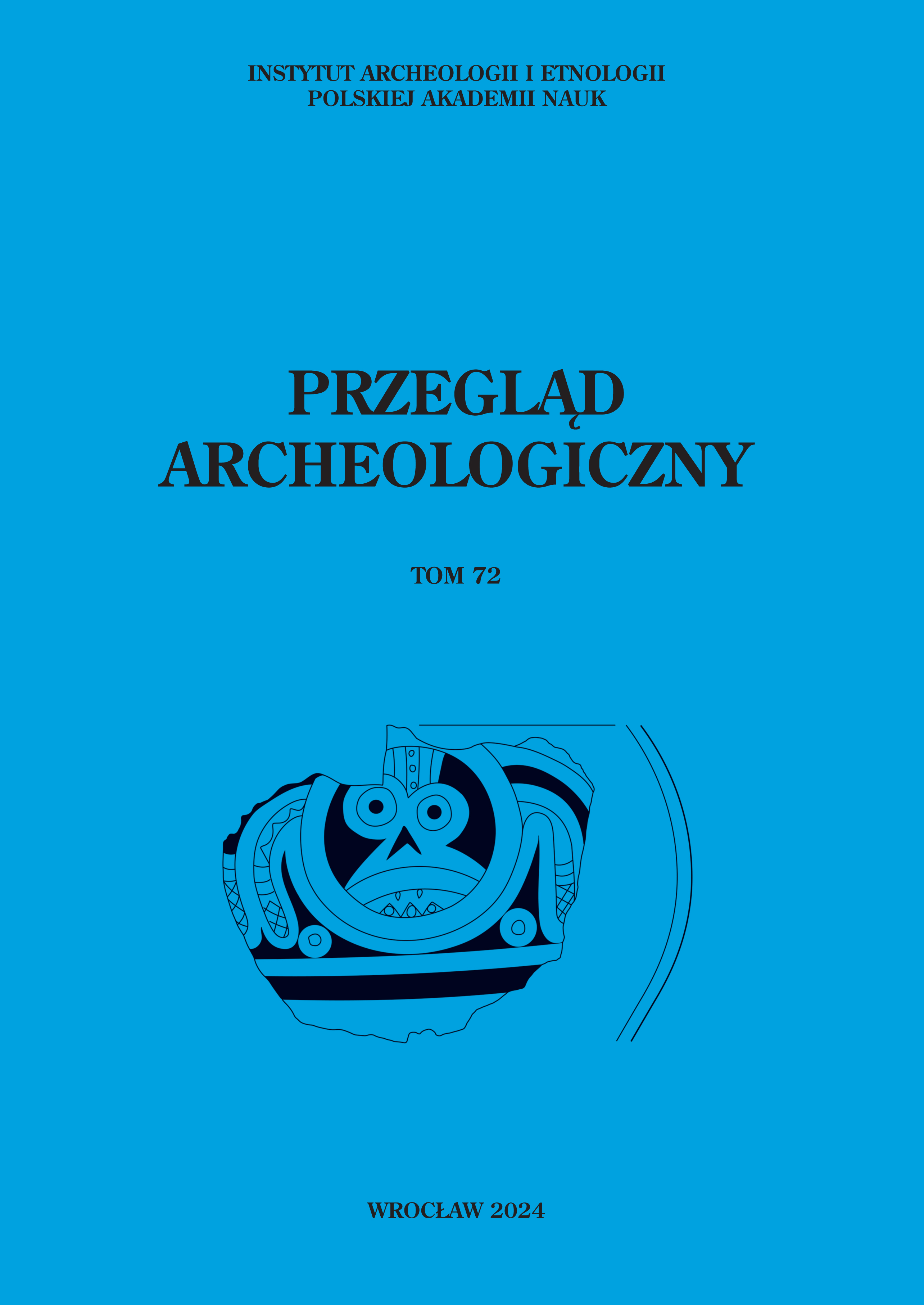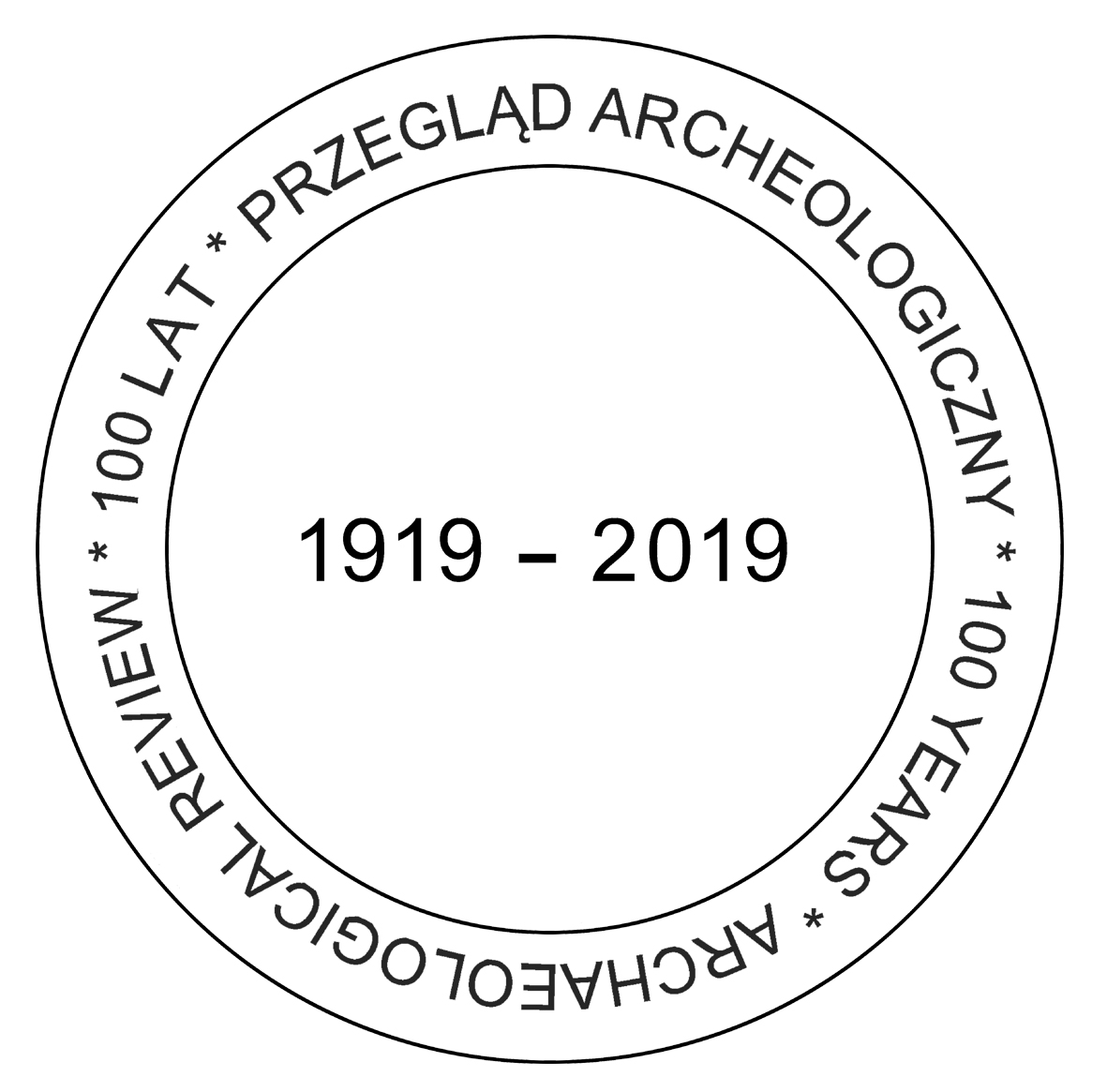Dualistic seasonal changes in the Late Glacial of the Central European Plain – towards a socio-archaeological concept of Late Palaeolithic mobility
DOI:
https://doi.org/10.23858/PA72.2024.3755Słowa kluczowe:
Late Palaeolithic, mobility, seasonality, hunter-gatherer studiesAbstrakt
The paper presents basic concepts regarding seasonal changes in hunter-gatherer societies (derived from processual, evolutionary and social theories) and the resulting models of mobility. The text presents the current applications of these models in studies on the Late Palaeolithic communities of the European lowlands and the reasons for their use. It also examines the possibilities and limitations of using an alternative dualistic model based on the newest research on the Late Palaeolithic settlement, particularly its early period related to the Hamburgian Culture occupation.
Pobrania
Bibliografia
Aureli F., Shaffner C., Boesch C., Bearder S., Call J., Chapman C., Connor R., Di Fiore A., Dunbar R.I.M., Henzi S.P., Holekamp K., Korstjens A.H., Layton R., Lee P.C., Lehmann J., Manson J.H., Ramos-Fernandez G., Strier K.B., Van Schaik C.P. (2008). Fission–fusion dynamics: new research frameworks. Current Anthropology, 49, 627-654. http://www.jstor.org/stable/10.1086/586708 . DOI: https://doi.org/10.1086/586708
Baales M. (1999). Economy and seasonality in the ahrensburgian. In: S. Kozłowski, J. Gurba, L. Zaliznyak (eds.), Tanged Points Culture in Europe (64-75). Lublin: Wydawnictwo UMCS.
Bailey G. (1960). A method of determining warmth and temperateness of climate. Geografiska Annaler, 43, 1-16. DOI: https://doi.org/10.1080/20014422.1960.11880936
Bettinger R., Garvey R., Tushingham S. (2015). Hunter-Gatherers: Archaeological and Evolutionary Theory (second edition). New York: Springer. DOI: https://doi.org/10.1007/978-1-4899-7581-2
Binford L. (1962). Archaeology as anthropology. American Antiquity, 28, 217-225. DOI: https://doi.org/10.2307/278380
Binford L. (1965). Archaeological systematics and the study of culture progress. American Antiquity, 31, 203-210. DOI: https://doi.org/10.2307/2693985
Binford L. (1978). Nunamiut ethnoarchaeology. New York: Academic.
Binford L. (1980). Willow smoke and dogs’ tails: hunter-gatherer settlement systems and archaeological site formation. American Antiquity, 45, 4-20. DOI: https://doi.org/10.2307/279653
Binford L. (2001). Constructing frames of reference: an analytical method for archaeological theory building using ethnographic and environmental data sets. Berkeley: University of California Press. DOI: https://doi.org/10.1525/9780520925069
Bird-David N. (1990). The giving environment: another perspective on the economic system of hunter-gatherers. Current Anthropology, 31, 183-196. DOI: https://doi.org/10.1086/203825
Boas F. (1966). Kwakiutl Ethnography (ed. H. Codere). Chicago: University of Chicago Press.
Bokelmann K. (1979). Rentierjäger am Gletscherrand in Schleswig-Holstein? Offa, 36, 12-22.
Bokelmann K., Heinrich D., Menke B. (1983). Fundplätze der Spätglazials am Hainholz-Esinger Moor, Kreis Pinnberg. Offa, 40, 199-239.
Bratlund B. (1994). A survey of the Subsistence and Settlement Pattern of the Hamburgian Culture in Schleswig-Holstein. Jahrbuch des Römisch-Germanischen Zentralmuseums Mainz, 41, 59-93.
Bratlund B. (1996). Hunting Strategies in the Late Glacial of Northern Europe. A Survey of the Faunal Evidence. Journal of World Prehistory, 10, 1-48. DOI: https://doi.org/10.1007/BF02226070
Conkey M.W. (1980). The Identification of prehistoric hunter-gatherer aggregation sites: The case of Altamira. Current Anthropology, 21, 609-630. DOI: https://doi.org/10.1086/202540
Fitzhugh B., Phillips C.S., Gjesfjeld E. (2011). Modelling hunter-gatherer information networks: an archaeological case study from the Kuril Islands. In: R. Whallon, W. Lovis, R. Hitchcock (eds.), Information and its Role in Hunter-gatherer Bands. Ideas & Perspectives (85-115). London: Cotsen Institute of Archaeology Press at UCLA. DOI: https://doi.org/10.2307/j.ctvdmwwz4.8
Garvey R., Bettinger R. (2014). Adaptive and Ecological Approaches to the study of Hunter-Gatherers. In: P. Jordan, V. Cummings, M. Zvelebil (eds.), The Oxford Handbook of the Archaeology and Anthropology of Hunter-Gatherers (69-91). Oxford: Oxford University Press. DOI: https://doi.org/10.1093/oxfordhb/9780199551224.013.001
Graeber D., Wengrow D. 2021. The dawn of everything. A new history of humanity. Milton Keynes: Allan Lane, Penguin Books.
Grove M. 2010. Logistical mobility reduces subsistence risk in hunting economies. Journal of Archaeological Science, 37, 1913-1921. https://doi.org/10.1016/j.jas.2010.02.017 DOI: https://doi.org/10.1016/j.jas.2010.02.017
Grove M., Pearce E., Dunbar R. 2012. Fission-fusion and the evolution of hominin social systems. Journal of Human Evolution, 62, 191-200. https://doi.org/10.1016/j.jhevol.2011.10.012 DOI: https://doi.org/10.1016/j.jhevol.2011.10.012
Henke W. 1986. Die magdalénienzeitlichen Menschenfunde von Oberkassel bei Bonn. Bonner Jahrbücher, 186, 317-366.
Ingold T. 2000. The perception of the environment: essays on livelihood, dwelling and skill. London: Routledge.
Jacobi R.M. 1980. The Upper Palaeolithic in Britain, with special references to Wales. In: J.A. Taylor (ed.), Culture and Environment in Prehistoric Wales: Selected essays (15-100). Oxford: British Archaeological Reports 76.
Jordan P., Cummings V. (2014). Analytical Frames of Reference in Hunter-Gatherer Research. In: P. Jordan, V. Cummings, M. Zvelebil (eds.), The Oxford Handbook of the Archaeology and Anthropology of Hunter-Gatherers (33-42). Oxford: Oxford University Press. DOI: https://doi.org/10.1093/oxfordhb/9780199551224.013.045
Kabaciński J., Sobkowiak-Tabaka I. (2009). Big game versus small game hunting: subsistence strategies of the Hamburgian Culture. In: M. Street, N. Barton, T. Terberger (eds.), Humans, environment and chronology of the late glacial of the North European Plain (67-75). Mainz: RGZM.
Kelly R. (2013). The lifeways of hunter-gatherers. The foraging spectrum. New York: Cambridge University Press. DOI: https://doi.org/10.1017/CBO9781139176132
Lane P. (2014). Hunter-Gatherer-Fishers, Ethnoarchaeology, and Analogical Reasoning. In: P. Jordan, V. Cummings, M. Zvelebil (eds.), The Oxford Handbook of the Archaeology and Anthropology of Hunter-Gatherers (104-150). Oxford: Oxford University Press. DOI: https://doi.org/10.1093/oxfordhb/9780199551224.013.024
Lehmann J., Boesch C. (2004). To fission or to fusion: effects of community size on wild chimpanzee (Pan troglodytes verus) social organisation. Behavioral Ecology and Sociobiology, 56, 207-216. DOI 10.1007/s00265-004-0781-x DOI: https://doi.org/10.1007/s00265-004-0781-x
Lehmann J., Korstjens A.H., Dunbar R.I.M. (2007). Fission-fusion social systems as a strategy for coping with ecological constraints: a primate case. Evolutionary Ecology, 21, 613-634. DOI: 10.1007/s10682-006-9141-9 DOI: https://doi.org/10.1007/s10682-006-9141-9
Levi-Strauss C. (1967). The social and psychological aspects of chieftainship in a primitive tribe: the Nambikwara of northwestern Mato Grosso. In: R. Cohen, J. Middleton (eds.), Comparative Politcal Systems (45-62). Austin: University of Texas Press.
Lowie R. (1948). Some aspects of political organization among the American Aborigines. Journal of the Royal Anthropological Institute of Great Britain and Ireland, 78, 11-24. DOI: https://doi.org/10.2307/2844522
Marlowe F. (2005). Hunter-Gatherers and Human Evolution. Evolutionary Anthropology, 14, 54-67. DOI: https://doi.org/10.1002/evan.20046
Mauss M., Beauchat H. (1979) [1906]. Seasonal variations of the Eskimo. London: Routledge.
Mugaj J. (2022). Seasonal Aggregation Site in Late Paleolithic – Intrasite Analysis of Large Hamburgian Encampment in Myszęcin, Western Poland. Lithic Technology, 47, 106-116. https://doi.org/10.1080/01977261.2021.1967580 DOI: https://doi.org/10.1080/01977261.2021.1967580
Nehlich O., Richards M. (2015). Dietary reconstruction of the two skeletons from Oberkassel by stable carbon and nitrogen isotope analysis from bone collagen. In: L. Giemsch, R. Schmitz (eds.), The Late Glacial burial from Oberkassel revisited (219-221). Darmstadt: Zabern.
Orschiedt J. (2018). The Late Upper Palaeolithic and earliest Mesolithic evidence of burials in Europe. Philosophical Transaction of the Royal Society, B 373. https://doi.org/10.1098/rstb.2017.0264 DOI: https://doi.org/10.1098/rstb.2017.0264
Pearce E. (2014). Modelling mechanism of social network maintenance in hunter-gatherers. Journal of Archaeological Science, 50, 403-413. https://doi.org/10.1016/j.jas.2014.08.004 DOI: https://doi.org/10.1016/j.jas.2014.08.004
Pedersen J.B., Maier A., Riede F. (2018). A punctuated model for the colonisation of the Late Glacial margins of northern Europe by Hamburgian hunter-gatherers. Quartär, 65, 85-104. DOI: 10.7485/QU65_4
Płonka T. (2012). Kultura symboliczna społeczeństw łowiecko-zbierackich środkowej Europy u schyłku plejstocenu. Wrocław: Wydawnictwo Uniwersytetu Wrocławskiego.
Płonka T., Kowalski K. (eds.) (2017). Rusinowo. The symbolic culture of foragers in the Late Palaeolithic and the early Mesolithic. Wrocław: Wydawnictwo Uniwersytetu Wrocławskiego.
Pulliam H.R. (1973). On the advantages of flocking. Journal of Theoretical Biology, 38, 419-422. DOI: https://doi.org/10.1016/0022-5193(73)90184-7
Riede F. (2014). Success and failure during the Lateglacial pioneer human re-colonisation of southern Scandinavia. In: F. Riede, M. Taallavaara (eds.), Lateglacial and postglacial pioneers in northern Europe (33-52). Oxford: British Archaeological Reports. DOI: https://doi.org/10.30861/9781407312316
Rust A. (1943). Die alt- und mittelsteinzeitliche Funde von Stellmoor. Neumünster.
Schild R., Królik H., Tomaszewski A.J., Ciepielewska E. (2011). Rydno. A Stone Age red ochre quarry and socioeconomic center. A century of research. Warsaw: Wydawnictwo IAE PAN.
Sobkowiak-Tabaka I. (2017). Rozwój społeczności Federmesser na Nizinie Środkowoeuropejskiej. Poznań: Wydawnictwo IAE PAN.
Sobkowiak-Tabaka I., Diachenko A. (2022). Approaching Late Paleolithic Seasonal Mobility on the North European Plain. In: I. Sobkowiak-Tabaka, A. Diachenko, A. Wiśniewski (eds.), Quantitative Archaeology and Archaeological Modelling (97-128). Springer. DOI: https://doi.org/10.1007/978-3-030-94368-4_5
Sobkowiak-Tabaka I., Kufel-Diakowska B. (2019). The shining piece of the puzzle: evidence of plant use in the Late Palaeolithic. Archaeological and Anthropological Sciences, 11(4), 1373-1389. DOI:10.1007/s12520-018-0604-z DOI: https://doi.org/10.1007/s12520-018-0604-z
Steward J. (1936). The economic and social basis of primitive bands. In: R. Lowie (ed.), Essays on anthropology in honour of Alfred Louis Kroeber (311-350). Berkeley: University of California Press.
Steward J. (1955). Theory of cultural change. Urbana: University of Illinois Press.
Street M., Terberger T., Orschiedt J. (2006). A critical review of the German Paleolithic hominin record. Journal of Human Evolution, 51, 551-579. https://doi.org/10.1016/j.jhevol.2006.04.014 DOI: https://doi.org/10.1016/j.jhevol.2006.04.014
Sturdy D.A. (1975). Some reindeer economies in prehistoric Europe. In: E.S. Higgs (ed.), Paleoeconomy (55-95). Cambridge: Cambridge University Press.
Trigger B. (2006). A history of archaeological thought. Cambridge: Cambridge University Press. DOI: https://doi.org/10.1017/CBO9780511813016
Vollbrecht J. (2005). Spätpaläolithische Besiedlungsspuren aus Reichwalde. Reichwalde 1. Dresden: Landesamtes für Archäologie mit Landesmuseum für Vorgeschichte.
Wengrow D., Graeber D. (2015). Farewell to the ‘childhood of man’: ritual, seasonality, and the origins of inequality. Journal of the Royal Anthropological Institute, 21(3), 597-619. DOI:10.1111/1467-9655.12247 DOI: https://doi.org/10.1111/1467-9655.12247
Weniger G.C. (1989). The Magdalenian in Western Central Europe: Settlement pattern and regionality. Journal of World Prehistory, 3, 323-372. DOI: https://doi.org/10.1007/BF00975326
White L. (1959). The evolution of culture. New York: McGraw-Hill.
Wild M. (2019). Coping with the risk through seasonal behavioural strategies. Schleswig-Holstein: Wachholtz.
Wiley R.H. (1991). Lekking in birds and mammals: behavioral and evolutionary issues. Advanced in the Study of Behavior, 20, 201-291. DOI:10.1016/S0065-3454(08)60322-8 DOI: https://doi.org/10.1016/S0065-3454(08)60322-8
Wiśniewski A., Kozyra C., Chłoń M. (2022). Reading the Mobility of Late Palaeolithic Hunter-Gatherers. Case Study from the Sowin Site Complex in Relation to Late Palaeolithic Sites North of the Sudetes and Carpathians. In: I. Sobkowiak-Tabaka, A. Diachenko, A. Wiśniewski (eds.), Quantitative Archaeology and Archaeological Modelling (47-68). Springer. DOI: https://doi.org/10.1007/978-3-030-94368-4_3
Pobrania
Opublikowane
Jak cytować
Numer
Dział
Licencja
Prawa autorskie (c) 2024 Przegląd Archeologiczny

Utwór dostępny jest na licencji Creative Commons Uznanie autorstwa 4.0 Międzynarodowe.















